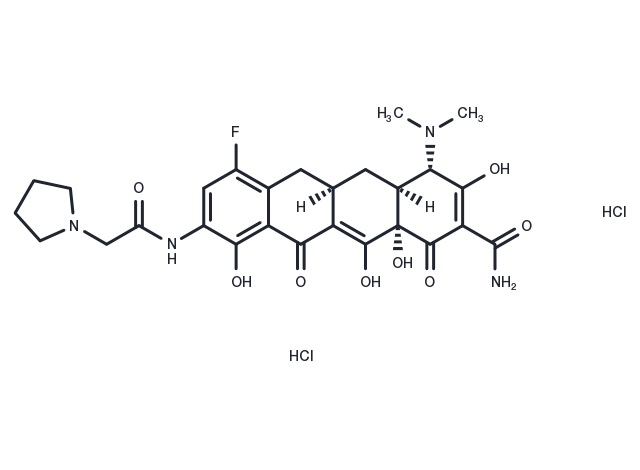Powder: -20°C for 3 years | In solvent: -80°C for 1 year


Eravacycline dihydrochloride (TP-434-046) is a potent and broad-spectrum antibacterial agent against six E. coli (MICs: 0.125-0.25 mg/L).

| Pack Size | Availability | Price/USD | Quantity |
|---|---|---|---|
| 1 mg | In stock | $ 197.00 | |
| 5 mg | In stock | $ 690.00 | |
| 10 mg | In stock | $ 872.00 | |
| 25 mg | In stock | $ 1,990.00 | |
| 50 mg | In stock | $ 2,680.00 | |
| 100 mg | In stock | $ 3,590.00 |



| Description | Eravacycline dihydrochloride (TP-434-046) is a potent and broad-spectrum antibacterial agent against six E. coli (MICs: 0.125-0.25 mg/L). |
| In vitro | Eravacycline shows inhibitory activity against A. baumannii, including isolates that are resistant to sulbactam, SM 7338, and BAY 41-6551(MIC50/90 = 0.5/1 mg/L)[1]. Eravacycline shows potent broad-spectrum activity against 90% of the isolates for all species panels (MIC90 0.008-2 μg/mL) except those of Pseudomonas aeruginosa and Burkholderia cenocepacia (MIC90 = 32 μg/mL). Eravacycline is active against multidrug-resistant bacteria including β-lactamases and antibiotics, including carbapenem resistance[4]. |
| In vivo | Eravacycline(3.125-50 mg/kg) shows mean fAUC/MIC magnitude associated with net stasis and 1-log kill endpoint of 27.97 and 32.60[2]. In mouse septicemia models, Eravacycline is efficacious against Staphylococcus aureus and demonstrates 50% protective dose values of ≤1 mg/kg. The PD50s are 1.2-4.4 mg/kg against Escherichia coli isolates[5]. |
| Synonyms | TP-434-046, TP-434 dihydrochloride |
| Molecular Weight | 631.48 |
| Formula | C27H33Cl2FN4O8 |
| CAS No. | 1334714-66-7 |
Powder: -20°C for 3 years | In solvent: -80°C for 1 year
DMSO: 135.0 mg/mL (213.8 mM), Sonication is recommended.
H2O: 45.0 mg/mL (71.3 mM), Sonication is recommended.
You can also refer to dose conversion for different animals. More
bottom
Please see Inhibitor Handling Instructions for more frequently ask questions. Topics include: how to prepare stock solutions, how to store products, and cautions on cell-based assays & animal experiments, etc.
Eravacycline dihydrochloride 1334714-66-7 Microbiology/Virology Antibacterial TP-434 TP-434-046 TP 434 Dihydrochloride TP 434 Eravacycline Eravacycline Dihydrochloride TP-434 Dihydrochloride TP434 Dihydrochloride TP-434 dihydrochloride TP434 inhibitor inhibit
